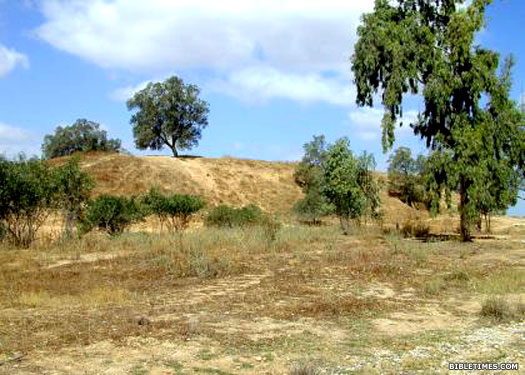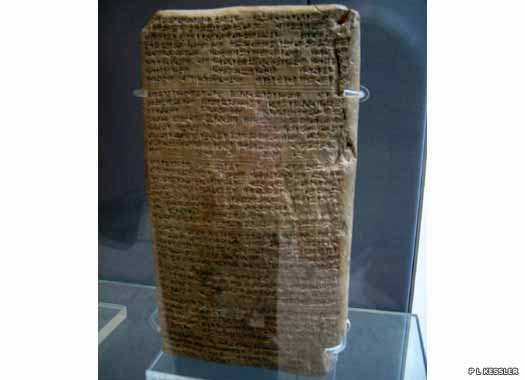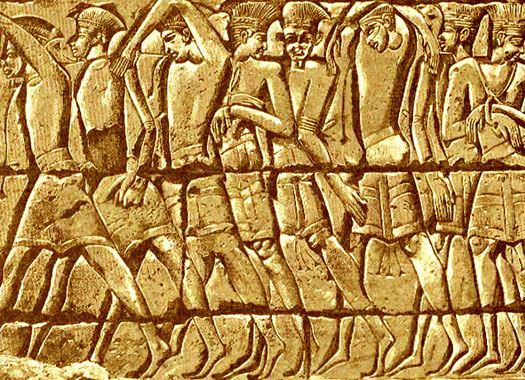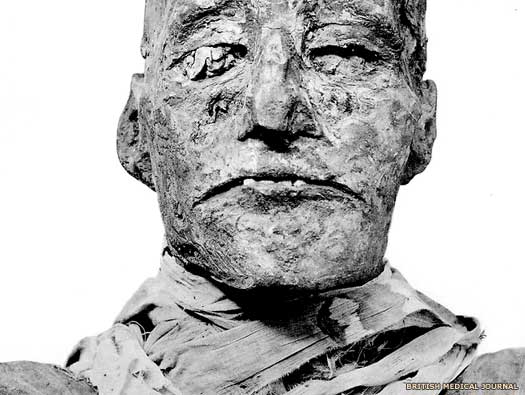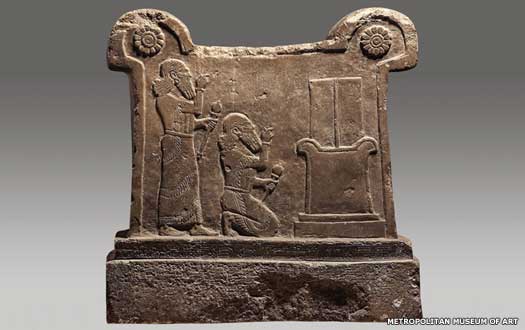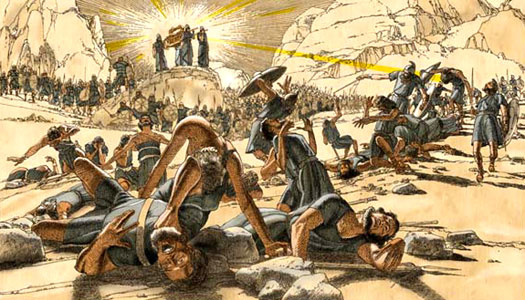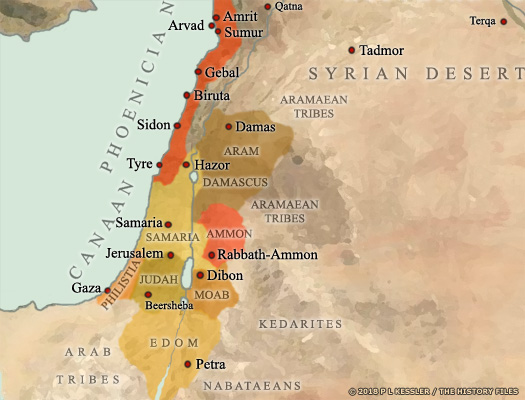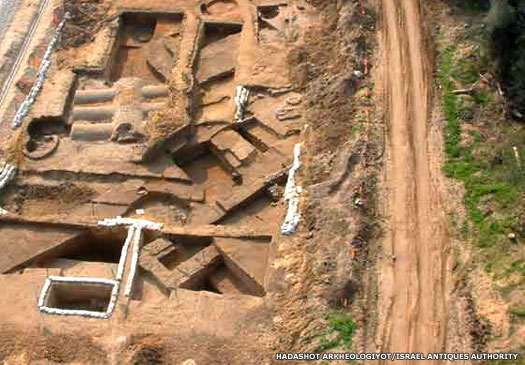
| PALESTINE Incorporating Gath, Gerar, & Gezer :
In the mid-third millennium BC, city states began to appear in Syria as the people there benefited from interaction with Sumer and from improvements in irrigation. Within five hundred years, around the 2000 BC mark, the same process was happening further south and west in the Levant, along the Mediterranean coast. Canaanite tribes occupied much of the area, creating a patchwork of city states of their own, each with their own petty king. Dated approximately to 1750 BC, the Old Testament claims that areas of Canaan were being settled by the early Israelites, although this was largely written down over a thousand years after the event so details have been distorted or lost. The Phoenicians (more Canaanites) also occupied parts of this region, eventually founding their own mighty seaborne trading empire.
A section of this region formed the later Palestine, although until the twelfth century BC there were no actual Palestinians as such. Instead the region witnessed the flourishing of various city states that were based around already ancient cities. Some of these had been founded as settlements by the early farming communities as long ago as 9000 BC or so, although they only began to resemble anything like the small cities they later became during the third and second millennia BC. The gene pool here was typically Levantine, so these people were regional natives. The Palestinians whose name was applied to the region by later generations arrived around 1200 BC in the form of the Philistines.
The city of Gerar enters the written historical record via the Old Testament. It is ruled by one Abimelech, possibly a title rather than a name as it is also used by his immediate (and only known) successor. The city was an important royal site during the time of Abraham and the early Israelite settlers, and they were welcomed in an event that can be dated roughly to around 1740 BC. The city was located on the southern border of the inhabited region of Canaan, near one of the big wadis of the Negev known as the Valley of Gerar. It ruled over large parts of the Negev and a number of smaller daughter cities (which were 'smote' by Asa of Judah in the late tenth century BC). In the land of Gerar the Israelite patriarchs found pasture for their flocks during years of drought, but their use of the wells in the area became contentious when native shepherds objected to the extra consumption during a period of hardship.
Gezer (not to be confused with the modern city of Gaza despite some modern claims to the contrary) is now an archaeological site by the name of Tel Gezer. Located in central Israel, it sits where the central mountains meet the northern Shephelah, around ten kilometres to the south-east of the city of Ramleh. The site was inhabited from around 3500 BC until the Roman period, by which time it had fallen out of use. The city of Gath, arguably located at modern Tell es-Safi in the central-western Gaza Strip, was one of the five royal cities of the later Philistines. It was the home of the famous Philistine champion, Goliath, but it seemingly fell out of use within the next six hundred years or so, by the 600s BC.
(Information by Peter Kessler, with additional information from The Amarna Letters, William L Moran (1992), from the Illustrated Dictionary & Concordance of the Bible, Geoffrey Wigoder (Gen Ed, 1986), from Palestine, Joshua J Mark (available via the Ancient History Encyclopaedia website), from Easton's Bible Dictionary, Matthew George Easton (1897), from the NOVA/PBS documentary series, The Bible's Buried Secrets, first broadcast 18 November 2008, from the Encyclopaedia Britannica, and from External Links: Time Maps, and Ancient DNA sheds light on the origins of the Biblical Philistines (Archaeology News Network), and The Land of Gerar, Y Aharoni (Israel Exploration Journal 6, No 1, 1956, pp 26-32, available via JSTOR), and Ancient History Encyclopaedia, and Encyclopaedia Britannica.)
c.2000 - 1800 BC :
In this period Amorites infiltrate Canaan, capturing some cities by force and creating others. Once they settle in, the area gradually becomes prosperous again. The principle Canaanite cities or small states at this time include Ammon, Amrit, Arvad, Biruta, Edom, Gebal, Gerar, Hazor, Shalem, Sidon, and Tyre.
The hilltop remnants of the city of Gerar lie approximately midway between Hebron and Raphia, for which two successive kings known as Abimelech ruled fl c.1740 BC :
Abimelech / Ambilek : Canaanite king in Palestine region. Reigned for c.40 years.
c.1740 BC :
King of the city of Gerar, Abimelech agrees ties of friendship with Abraham after the latter has settled his early Israelite people in Canaan. The same name is repeated more than once in relation to the later Philistines, seemingly in reference to multiple kings. It is thought to mean something along the lines of 'superior [man] or father who is king', and could be an obscure title used in the region, rather than a name - the local equivalent of 'pharaoh'. To back up this suggestion, the Hebrew text, the Haggada, mentions 'Benmelech' (another title, this time referring to the crown prince), 'son of Abimelech', who becomes king himself and changes his 'name' to Abimelech.
fl c.1700 BC :
Abimelech : Son. Became 'Abimelech' of Gerar upon succeeding his father.
c.1700 BC :
A late son of Abraham of the Israelites, Isaac is his successor as leader of the early Israelites. He lives much of his life in Hebron and eventually dies there, but with at least one interruption in the meantime - during a period of famine he (and by inference his tribe) is forced to seek refuge with the Canaanite ruler of later Philistine territory, Abimelech of Gerar (son of the Abimelech who had previously had dealings with Abraham). Abimelech later visits Isaac when he is encamped at Beer-sheba, and expresses a desire to renew the covenant which had been entered into between their fathers.
c.1700 - 1650 BC :
Famine in the region could be the reason for the early Israelites migrating south into Egypt around this time, while Palestinian groups of Canaanites may follow the same route, invading Lower Egypt as the Hyksos. More recent theories have diverted away from the idea that it is Hyksos Egypt that the Israelites enter. Some scholars place the early Israelites even earlier, by as much as four centuries, with them interacting with Twelfth Dynasty Egypt. Another school of thought prefers a much earlier period, Third Dynasty Egypt under Zoser, based on the idea that early Egyptian dating is still incorrect, with Menes being placed up to seven hundred years too early.
Small cities and minor states that had been founded by the Hittites littered the meeting point between Anatolia and Syria around 1500 BC c.1478 BC :
A resurgent Egypt expands rapidly northwards through Palestine, sometimes inflicting severe destruction on cities there and threatening Mitanni possessions in Syria.
fl c.1360s BC :
Milkilu : King of Gezer who was attacked by Labaya of Shalem.
c.1360s BC :
The Amarna letters between Egypt and the city states of Syria and Canaan describe the disruptive activities of the habiru, and of Hazor, which is accused of siding with them to capture several cities belonging to Tyre and Ashtaroth. The ruler of Tyre in the very same period in which Milkilu is king of Gezer is one Abi-Milki, who is often the subject of speculation by scholars who wonder if he is linked to the frequent mentions of various Philistine rulers named Abimelech. Could Abi-Milki of Tyre and Milkilu of Gezer be one and the same person, or could they both be using 'Abimelech' as a title, as described above around 1740 BC?
fl c.1360s BC :
uwardata / uardatu / Shuwardata : King of Gath.
c.1360s BC :
uwardata is thought to be the king of Gath at this time, although an alternative reading of the Amarna letters places him as a guardian or mayor of Qiltu (possibly Keilah - a town in later Judah - or Qi'iltu).
This contemporary cuneiform tablet is inscribed with a letter from Tushratta, king of Mitanni, to Pharaoh Amenhotep III, and covers various subjects such as the killing of the murderers of the Mitanni king's brother and a fight against the Hittites c.1200 BC :
General instability grips the Mediterranean coast and a dark age follows which doesn't fully fade until the tenth century BC. In Palestine, the urban culture that had previously characterised the region is gradually replaced by one of villages, showing a decline in living standards and a collapse (or at least a noticeable lessening) in the more civilised elements of life. New settlers arrive in the region while most of the territory is under Egyptian control. Other cities, such as Damas in the near north, are also settled by new arrivals, the Aramaean tribes, and these cities eventually flourish.
Philistines (Philistia) :
The Philistines (Peleshet) were one of the Sea Peoples who were the cause of so much destruction along the Mediterranean coast at the end of the twelfth century BC. There was general instability in the region; the Hittite empire had been destroyed in Anatolia, and various Hittite vassal city states were being attacked in Syria. The Philistines themselves, settling on the southern coast of the Egyptian-controlled Levant as far south as the Egyptian border (which was usually further north than it is today), are generally agreed to be Mycenaean descendents (possibly from Crete) who were probably displaced by the Dorian invasions of Greece.
Along with other groups who were settled in the region by Egypt, including the Danya and the Tjekker, the Philistines adopted local Canaanite culture and language before they left any written texts, and established a pentapolis of five cities which regulated access into Egypt. These were Ashkelon, Ashdod, Ekron, Gath (arguably located at modern Tell es-Safi in the central-western Gaza Strip), and Gezer, already ancient settlements that had been founded as much as seven thousand years before the arrival of the Philistines. Previously they had been controlled by various groups that included the early 'Palestinians', the aforementioned Canaanites. Now under Philistine control these cities formed a formidable confederacy. Each enjoyed great autonomy and was ruled by a seranim, the head of a council.
The arrival at this time of the Philistines is confirmed by archaeological evidence which also confirms that the city of Gezer was destroyed and abandoned for a generation. DNA evidence supports an arrival around this time - the twelfth century BC - of people with a European-derived ancestral component. which was not present in the ruling elite they replaced. However, within about two centuries that European element was gone, replaced by fully local Levantine DNA. The Peleshet may have been relatively small in number but highly advanced in terms of arms and fighting ability, allowing them to take over the region and dominate as a new layer of nobility. Then they intermarried with the natives to quickly replace the European elements in the DNA of their descendants.
There are two schools of thought when it comes to the creation of the name 'Palestine'. One favours the word 'plesheth', which refers to a 'root palash', an edible culinary delight that was carried by migratory tribes (such as the Philistines) and which came to be used to refer to any nomadic tribe. The alternative - and far more popular - version suggests that the Greeks named the region after the people. The entire Syrian and Levant region was under Greek control following the campaigns of Alexander the Great, and so it was very much within the Greek sphere. A third theory involves writers such as Tom Robbins suggesting that the name originates from the androgynous god, Pales, who was widely worshipped in the region. It was not at all uncommon for barbarian tribes to take the name of their god, but that would merely have created the Philistines, still leaving it to the Greeks to apply that name to the region. Various Celtic tribes were named either directly or indirectly after their gods, including the Ambarri, Atuatuci, Brigantii, and Sequani, so the practice is one that is widely accepted by historians.
(Information by Peter Kessler, with additional information from Palestine, Joshua J Mark (available via the Ancient History Encyclopaedia website), from Easton's Bible Dictionary, Matthew George Easton (1897), from the Illustrated Dictionary & Concordance of the Bible, Geoffrey Wigoder (General Ed, 1986), from A Royal Dedicatory Inscription from Ekron, S Gitin, T Dothan, & J Naveh (Israel Exploration Journal 47, 1997), from the NOVA/PBS documentary series, The Bible's Buried Secrets, first broadcast 18 November 2008, from Ancient Israel and Its Neighbors: Interaction and Counteraction, Nadav Na'aman (Eisenbrauns, 2005), and from External Links: Time Maps, and Ancient DNA sheds light on the origins of the Biblical Philistines (Archaeology News Network).)
1208 BC :
In a brief addendum to his victory stele. Pharaoh Merneptah of Egypt mentions that Ashkelon, Gezer, and Yanoam (in the north Jordan Valley) have been captured and that Israel 'has been shorn. Its seed no longer exists'. The first two cities have probably already been captured by the invading Philistines and are therefore targets for 'rescue' by a civilised king. Israel, too, is the name given to a recently-arrived or formed group which would need to be brought to heel (although the claim that its seed no longer exists is mere boastfulness). This is the earliest definitive mention in history of a people named 'Israel'.
This photo shows a relief from Medinet Habu which details Philistines with their distinctive feathered headdresses, making them an unusual sight on the battlefield c.1200 BC :
The Danya, or Danites, are either the dispossessed previous owners of the territory now occupied by the Philistines, or fellow Sea Peoples. The Philistines seem to bear them a particular grudge and they are forced to move inland where they apparently join the Israelite confederation of tribes.
c.1186 - 1168 BC :
The Philistines move inland from the coast and briefly conquer and occupy areas of Canaan, including the settlements of the Israelites. Archaeological evidence for a mass settling of people at this time has yet to be found, suggesting that the Philistines are formed of small, mobile groups who take a while to establish themselves and take control of the region.
1179 - 1172 BC : In his fifth year (1179 BC), Ramses III fights off attacks from people from the north, almost certainly the Sea Peoples. In his eighth year (1176 BC), as well as defeating another attack, he provides an overview of the general collapse in the eastern Mediterranean in the face of attacks by the Sea Peoples. The twelfth year (1172 BC) sees another attack. However, Ramses may be claiming the victories of his predecessor, Merneptah, although his statements do highlight Egypt's loss of influence outside its own borders by this date.
The mummy of the last great pharaoh, Ramses III, revealed the fact that his throat had been slit to a width of seven centimetres, more then enough to kill him instantly There is a possibility that these defeated Sea Peoples include the Philistines (or further elements of their groups), the defeat forcing them to settle Canaan instead. Either that, or they are now using Canaan as a base from which to launch further attacks against Egypt.
c.1160 BC :
The Jebusites are conquered by the Israelites, as are many other Canaanite city states situated in and around what becomes Judah and lower Syria, with Dor and Gezer amongst their number. Referring to them as city states may be a little grand. Probably they are little more than obscure settlements and small tribes that are taken over piecemeal.
c.1160? BC :
Horam : King of Gezer. defeated by Israelites?
c.1150 - 1110 BC :
Egypt loses overlordship of the region to Assyria. The Philistines take the opportunity to re-conquer the Israelites and establish vassal kings there until they are forced out around 1110 BC.
The latter event takes place thanks to Samson. The first recorded event in his life is his marriage to a Philistine woman of Timnath. An unblessed marriage, his wife is soon taken from him and given 'to his companion'. In echoes of modern Levantine politics, Samson takes revenge by burning the 'standing corn of the Philistines'. They in turn 'burn his wife and her father'. Her death is avenged 'terribly' by Samson. And so the cycle of violence rests for a while. Following this, Samson serves as a judge for the Israelites for twenty years before becoming infatuated with Delilah, and is betrayed by her. He meets his death leading the Israelites in freeing themselves from the control of the Philistines.
Shown here is a cult pedestal of the god Nuska which came from from the Temple of Ishtar and was apparently produced during Tukulti-Ninurta's reign (1244-1207 BC) c.1100 BC :
Egyptian documentary evidence apparently confirms that the Peleshet, Sherden, and Tjekker are still settled in Philistia. The Tjekker are also placed in Dor. The Peleshet would appear to be the dominant force, either originally or in time, as the other two names are quick to fade from history.
Around this time there is the occurrence of another Abimelech (see above), although this time within the territory of the Israelites rather than that of the Philistines. Upon the death of Gideon, his son, Abimelech, is proclaimed king. One of his first acts is to murder his brothers, seventy in number, 'on one stone', at Ophrah. Only one of them by the name of Jotham escapes. Abimelech is an unprincipled, ambitious ruler, one who is often engaged in war with his own subjects. When engaged in reducing the town of Thebez, which had revolted, he is struck mortally on his head by a millstone that is thrown by the hand of a woman from the wall above. Perceiving that the wound is mortal, he desires his armour-bearer to thrust him through with his sword so that it might not be said he has perished by the hand of a woman.
c.1050 BC :
Phoenician expansion southwards along the coast is halted by the Philistines. They are clearly powerful enough at this stage to be able to resist one of the region's most quickly growing trading empires.
Shiloh is a Canaanite town that has become the central sanctuary site of the Israelite confederacy during the period of the judges. Following the Israelite conquest of Canaan, the Tabernacle and the Ark of the Covenant had been installed in Shiloh, but the Ark is now captured by the Philistines during a battle at Ebenezer (site unknown), and Shiloh is soon afterwards destroyed. Excavations at Khirbat Sayūn in modern Jordan during 1920-1932 suggest that Shiloh remains a ruin for several centuries. The Philistines decide to return the Ark after about seven months.
The Israelite Ark of the Covenant is the stuff of legend, but it does figure noticeably in the early centuries of Israel's history and, despite being captured by the Philistines around 1050 BC, it seems that even they couldn't hold onto it for long Maoch : Ruler of Gath?
fl c.1005 BC :
Achish / Abimelech? : Son. Ruler of Gath.
975 BC :
According to the Old Testament, the Philistines are subdued by David of Israel after he defeats their champion, Goliath, a resident or son of the city of Gath (at this time possibly the greatest and most powerful of the Philistine city states). There is so far no archaeological evidence for any Israelite influence in the area and, indeed, the available evidence points to the Philistines ruling the area until at least the ninth or eighth century.
The inference is that the Philistines at least retain a level of autonomy even if they are beaten by the Israelites, and even more that the Old Testament's claim of subduing them could merely be a boastful way of claiming a minor victory in a tribal skirmish. However, the defeat does see the replacement of the seranim with kings who rule virtually independently of the councils. The establishment of a stronger leadership in the face of one or more losses in the tribal skirmishes, perhaps?
Maacah? : Son? Ruler of Gath or the name of a village?
fl c.960s BC :
Achish : Son. Ruler of Gath.
c.960s? BC :
A ruler of Gath named Achish, who is probably the grandson of Achish, is mentioned in connection with two servants of Shimei who flee to him. Shimei goes to Gath in pursuit of them, in breach of Solomon's orders, and is subsequently put to death by Solomon. Achish is said to be the son of Maacah, but this could instead mean that he is from a place called Maacah. There exists a small Aramaean kingdom of this name in northern Jordan, around the town of Abel Beth Maacah. This and Geshur are situated between Gilead and Mount Hermon, bordering the kingdom of Og in Bashan in the Old Testament. Maacah becomes an Israelite city following its conquest by King David, possibly as late as the 960s BC, around the time at which Achish is king in Gath.
905 BC :
Nadab, king of Samaria, is killed by Philistines who have been able to regroup into larger political structures following the division of Israel into Samaria and Judah.
884 - 824 BC :
Assyria during this period begins to encroach on the region, conquering some cities. Under Hazael, Damas expands its own borders by annexing all the Hebrew possessions east of the Jordan, ravaging Judah, and rendering Israel impotent. From inscriptions by Shalmaneser III of Assyria it appears that Hazael also withstands an attack by the Assyrian army and keeps Damas, Syria, and Philistia independent (although he does seize the city of Gath). However, his actions against his neighbours unleashes a long series of conflicts with Jerusalem. Gath is subsequently besieged and then destroyed, towards the end of the century, and it never recovers.
When the Neo-Assyrian empire threatened the various city states of southern Syria and Canaan around 853 BC, they united to protect their joint territory - successfully it seems, at least for a time c.850 BC :
Philistines sack Jerusalem in Judah, along with Arabs and Ethiopians, who loot King Jehoram's house, and carry off all of his family except for his youngest son, Jehoahaz.
? - 734 BC :
Hununu : Ruler of Gezer. Submitted to Assyria.
734 BC :
The city states of Philistia, Ekron, Ashdod, Ashkelon, and Gezer become vassals of Assyria. Raphia, the southernmost, seems to remain independent. Hununu of Gezer flees to Egypt, possibly after having submitted to Assyria (as shown on a frieze).
722 - 720 BC :
Philistia, by now reverted to its original territory - a coastal strip of land situated roughly in the same place as the modern Gaza Strip - is part of a rebellion in 722 BC along with Moab, Judah, and Edom against Assyrian overlordship of the region. The rising is apparently put down. The Philistines also support Mardukapaliddina II in his successful bid to usurp the Babylonian throne. In 720 BC the city of Gezer is made a puppet state of Assyria.
713 - 712 BC :
The city of Ashdod, which lies along the Mediterranean coastline in modern southern Israel, becomes a puppet state. The following year its statehood is ended and it is made a province of Assyria. Two subsequent kings are known - Mitinti (during the reign of Assyria's Sennacherib, 705-681 BC) and Akhimilki (during the reign of Esarhaddon, 681-669 BC), but both must be assumed to be imported from elsewhere following the destruction of Philistia in 704-701 BC. A modern Ashdod is established near the ancient ruins in 1956.
The city of Ashdod suffered declining fortunes after being destroyed by Egypt in 950 BC and laying largely abandoned for around a century and-a-half, with subsequent re-inhabitation not being enough to rescue it from eventual abandonment 704 - 701BC :
The end of the region known as Philistia (Palestine), as well as the remaining cultural Philistines, now comes when the Assyrians sack the remaining towns and cities and sells the inhabitants into slavery. The city of Ashkelon may be the last to fall, in 701 BC. Subsequent kings appear in Ashdod and Ekron (at least), but they write their inscriptions in a Canaanite dialect that is very close to Phoenician. The land is subsequently claimed by the Persian empire and governed by Phoenicians (principally the city of Tyre) before being taken by Alexander the Great's Greek empire, and then the Rome republic and empire as the province of Judea.
Under the Romans the people are generally free, within reason, to adhere to their own cultures and religious beliefs. After the Bar-Kochba revolt of AD 132-135, however, Emperor Hadrian is so enraged by Jewish resistance that he re-names the province Syria Palaestina (after the two traditional enemies of the Jews, the Syrians and the Philistines). With the rise of the Eastern Roman empire under Constantine the Great, Palestine became a Christian province and remains so from AD 330-640 when the region falls to the invading forces of Islam. As Islamic Palestine, the region continues to be a war-torn and much-contested one throughout the Crusades and into the modern age, where it is locked in perpetual strife with its immediate neighbour in the form of Modern Israel & Palestine.
Source :
https://www.historyfiles.co.uk/ |
